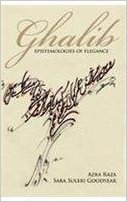Epistemologies of Elegance is a book comprising twenty-one ghazals of Ghalib that are favourites of Azra Raza and Sarah Suleri Goodyear. Raza is, surprisingly, a research scientist and cancer specialist who was born in Karachi and now lives in Manhattan. It makes a pleasant change to have a medical doctor venturing into this field. Her co-author Goodyear was also born in Karachi and is now a Professor of English at Yale University and has written several books, including The Rhetoric of English India. Both these women adore the poetry of Ghalib, and their modestly stated aim is to share their enthusiasm with others, and in particular to make Ghalib’s Urdu poetry more accessible to people who would love to know him better but have been handicapped by the debilitating linguistic consequences of an English medium education.
The authors sum up their aim with a quotation from Wordsworth, ‘What we have loved, Others will love, and we will teach them how’. There are now quite a number of books targetting this audience. Many have been afflicted with the strangest or the most arcane English titles. The name ‘Epistemologies of Elegance’ itself, although alliterative, would seem to be calculated to put off all but the kind of people who write obscure music notes on the back of CDs. Then there is the recent collection of ghazal translations entitled The Lightning should have fallen on Ghalib, seeming to imply that it would have been much better if the poet had been struck dead than lived long enough to write his Diwan. Even Shama Futtehally’s wonderful ghazal anthology, Slivers of a Mirror, does not have a title that would have readers lining up at bookshops.
The present volume could also have been more attractively produced. The Urdu ghazals are printed not in the flowing nastalliq script that is generally considered appropriate for Urdu poetry, but in the ordinary squat letters of a standard typeface. Most verses have vocabulary that may give readers problems, but the authors do not explain them; instead they decided to provide a literal translation of each verse that only partially solves this problem. Their most important contribution is their own imaginative commentary on the meaning of each individual verse.

